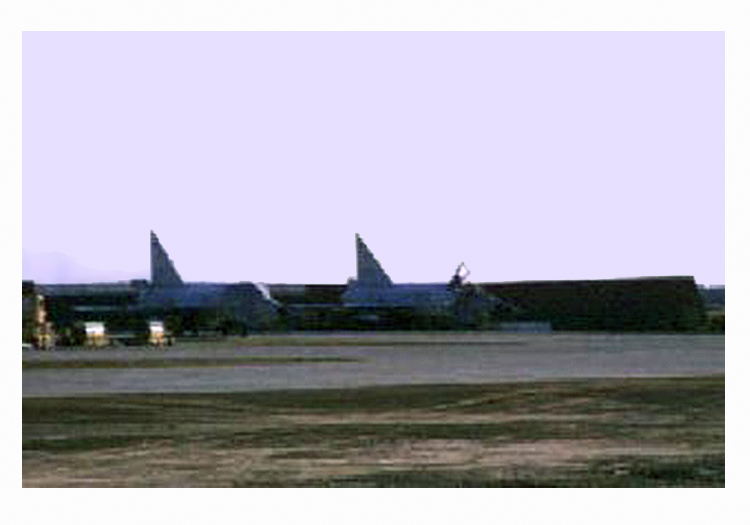
I "hit the sack" around 2300 hours, 30 June, 1965. At approximately
0132 hours, 1 July, 1965, the first incoming mortar rounds
hit the base on the South end of the runway and aircraft parking
area, where the alert
F-102 interceptor aircraft, and two C-130 flare ships were
parked. Later, Monkey Mountain Radar reported that the NVA
had six mortar rounds in the air before the first round impacted
- they were very good!
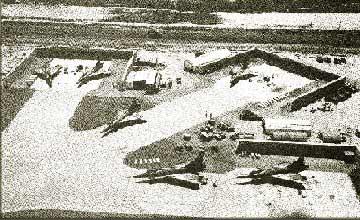
The mortar fire then shifted (they reportedly had three mortar
tubes working us over) and started "walking" fire up the flight line...
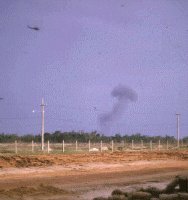
The "Sapper" attack on the
south end of the base occurred as follows:
The NVA (guided
by local VC) had infiltrated the southeast perimeter through
five holes cut in the perimeter fence. Their strength was estimated
at approximately 60 personnel. The main force consisted of
"hard-core" NVA--not VC. We knew this at once because of the
sound of AK-47 fire. At that time, only the NVA carried the
AK-47 -- not the VC..

After successfully infiltrating the base perimeter
undetected, the enemy force grouped behind two large concrete
revetments area, in which two C-130 flare ships were parked. There,
they waited for the mortars to open up. That would be their
signal to begin their attack.
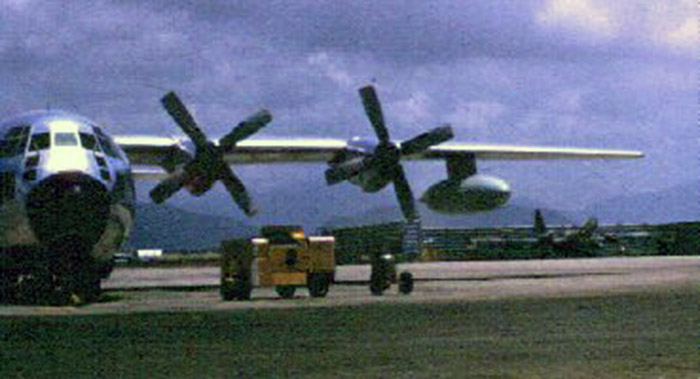 When the mortar fire began, the NVA force advanced in assault
under their own fire across the taxiway. As they moved past
the revetments, the NVA ripped open the fuel cells in the
C-130's with automatic weapons fire, threw grenades into the
fuel and fired the aircraft, destroying them. A team of NVA
worked their way around behind the alert F-102's, and fired
either RPG's or 57mm recoiless rife rounds up the engine exhaust
pipes of three of the aircraft, destroying them.
When the mortar fire began, the NVA force advanced in assault
under their own fire across the taxiway. As they moved past
the revetments, the NVA ripped open the fuel cells in the
C-130's with automatic weapons fire, threw grenades into the
fuel and fired the aircraft, destroying them. A team of NVA
worked their way around behind the alert F-102's, and fired
either RPG's or 57mm recoiless rife rounds up the engine exhaust
pipes of three of the aircraft, destroying them.
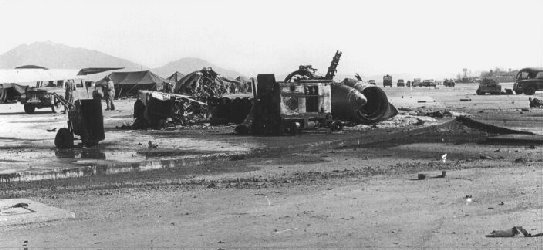
All of the F-102's were parked "cocked" with the canopies
open. The NVA destroyed or disabled the remaining aircraft
with automatic weapons fire, and by throwing grenades and satchel charges into the open cockpits. Air-to-air rockets on-board the burning F-102's burned, exploded, or
"cooked off," and launched north towards the cantonment area
and other aircraft parked on the rest of the flight line.
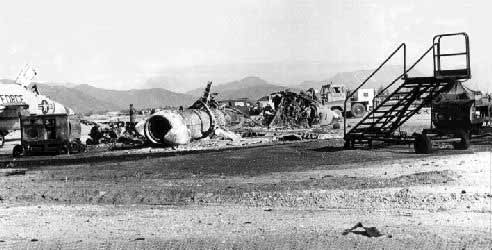

Only two posts were located
at the south end of the base. One was a checkpoint, (not an
access control point) located on the west edge of the taxiway
across from, and approximately 50 yards North of the first
C-130 revetment. The second was a position located at the
juncture of the taxiway, and the active runway, near the runway
over-run area.
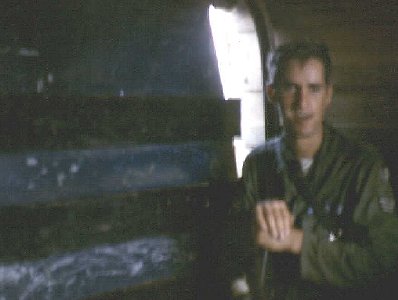 Many times, off duty troops could not sleep for one reason
or another, and would go over to [Command Security Control]
CSC, check out the ton-and-a-half truck, and run coffee around
to the troops on post. Sometimes, the Flight on-duty would
assign someone to do this, but usually someone off-duty would
just "volunteer." I had performed that duty just two nights
before the attack.
Many times, off duty troops could not sleep for one reason
or another, and would go over to [Command Security Control]
CSC, check out the ton-and-a-half truck, and run coffee around
to the troops on post. Sometimes, the Flight on-duty would
assign someone to do this, but usually someone off-duty would
just "volunteer." I had performed that duty just two nights
before the attack.
[Photo of A1C Don Jones (VSPA LM 426) in a truck like SSgt Jensen drove that
night. Patched Ak-47 holes are over the cab]
On the fateful night,
SSgt Jenson was running coffee. He was armed only with a .38
caliber revolver, and basic load of ammunition. (Up to that
point, we were still state-siding it as far as weapons
and ammunition were concerned.) In those days, the Air
Police were thought of as little more than internal point
security guards for critical resources. We were neither trained,
nor equipped to fight an actual ground engagement against
a determined enemy. Only a few troops wore steel helmets -- flack
jackets were not an issue item. We were authorized only basic
load of ammunition for the M16 rifles (three 20 rd. magazines).
We were neither issued nor authorized grenades, or M60 machine
guns. We carried nothing that wasn't carried at a CONUS base.
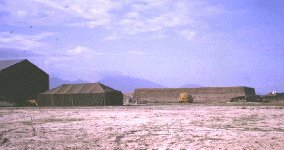 At approximately
0129 hrs, SSgt Jenson pulled up in the truck to the check-point
at the F-102 Alert Area. The check-point was manned by a young "two-striper," last name of Handy, first name unknown. Handy
was TDY to Đà Nàng from George AFB, and had been in-country about a week. SSgt Jenson told Airman Handy that the "coffee
jug was in the back of the truck" if he wanted some.
At approximately
0129 hrs, SSgt Jenson pulled up in the truck to the check-point
at the F-102 Alert Area. The check-point was manned by a young "two-striper," last name of Handy, first name unknown. Handy
was TDY to Đà Nàng from George AFB, and had been in-country about a week. SSgt Jenson told Airman Handy that the "coffee
jug was in the back of the truck" if he wanted some.
At that moment, the first mortar
rounds impacted at the end of the runway -- approximately 200
yards from where SSgt Jenson and Airman Handy were located.
At the same time, the NVA force moved from behind the C-130
revetments, and across the taxiway, firing as they advanced,
into the small tent/trailer area, located between the taxiway
and the active runway where the alert crews, and maintenance
troops were billeted.
Over the noise of
the enemy's fire and explosions, SSgt Jenson yelled at Airman
Handy to "Get the radio in the bunker," as the truck
that SSgt Jenson was driving was not radio equipped. SSgt
Jenson dismounted the vehicle on the driver's side (preparing
to engage the sapper team), and was immediately struck once
in the lower abdomen by a 7.62 X 39 mm. AK-47 round. SSgt
Jenson went to his knees, and though painfully wounded, drew
his .38 caliber revolver, and returned fire at three NVA soldiers
at a range of appriximately 30 yards. SSgt Jenson fired three
rounds, and witnesses later recounted that two of the NVA
soldiers went down -- no enemy bodies were found as the NVA
always removed the bodies of their dead upon withdrawal.
Seeking better cover, SSgt
Jenson managed to crawl around the rear of the vehicle, where
he took up a position behind the right-rear tandem wheels,
and prepared to re-engage the enemy. An NVA soldier who had
approached SSgt Jenson's truck from the front, threw a grenade
into the cab. When the grenade detonated, the vehicle [SSgt
Jenson was behind] burst into flames. In the ensuing confusion,
the NVA soldier managed to circle around the rear of the burning
[ton-and-a- half truck], and approach SSgt Jenson undetected.
The NVA soldier stood over [the gravely wounded] SSgt Jenson
and fired four rounds into his upper and middle back, killing
him instantly.
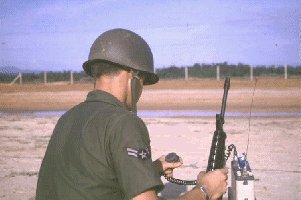 [Meanwhile,] Airman Handy had been attempting to contact CSC
with the radio located in the bunker (a large "portable" non-tactical Motorola radio, not a small hand-held radio which he could
have worn in a belt carrier case), with negative results.
Handy reportedly looked up from inside the bunker (which was
nothing more than a ring of single sandbags approximately
three and one-half feet high, and with no overhead cover),
and saw the NVA that had just killed SSgt Jenson.
[Meanwhile,] Airman Handy had been attempting to contact CSC
with the radio located in the bunker (a large "portable" non-tactical Motorola radio, not a small hand-held radio which he could
have worn in a belt carrier case), with negative results.
Handy reportedly looked up from inside the bunker (which was
nothing more than a ring of single sandbags approximately
three and one-half feet high, and with no overhead cover),
and saw the NVA that had just killed SSgt Jenson.
Handy then brought his M16
rifle to bear, and killed the NVA soldier. Airman Handy then
remained at his post, and delivered flanking fire on the advancing
NVA line, and broke their assault. Airman Handy continued
to engage the enemy until his ammunition was exhausted.
An captured NVA officer later
revealed that the initial objective of the attack was to eliminate
the Marine Aviation Battalion Helicopters, which were hurting
NVA operational efforts in the local Đà Nàng area. The NVA
officer further related that when Airman Handy had opened
fire on their advance, they were convinced they had run into
a "dug-in heavy machine gun" -- broke off their attack
and began to withdraw by the same route by which they had
entered the flight line area.
In the light of the burning
aircraft, the NVA could be seen dragging dead and wounded
toward the fence line. The NVA were also engaged by the F-102
crew members and maintenance personnel in the tent area, who
were lightly armed with a few unauthorized M16's and
hand weapons.
The Marines, from the aviation
battalion, also contributed effective fire from their positions
across the active runway to the west. [In 1965, there was
only a single runway, with one under construction.]
I will never forget the sight
of an Air Force Major, dressed in a flight suit and hatless,
sitting on the hood of a jeep with an M16 rifle in his right
hand, barrel pointed upward, with the butt anchored against
his right hip --tear filled eyes staring unwaveringly straight
ahead. SSgt Jenson's body was draped across the Major's lap,
and his head gently cradled and supported by the Major's left
arm as the jeep moved slowly down the taxiway toward the Air
Force compound. No fallen warrior could have had a more solemn,
profound, and appropriate escort.
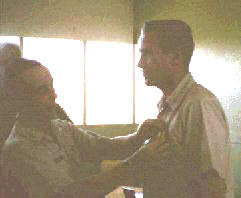 You said that you sent a picture of a Major receiving a medal... that
was probably our "commander" at the time, an Major Howard,
I believe his name was. I don't know if it was him that brought
Terry's body in. I know that it was a Major in a flying suit,
and Major Howard was a pilot that wound up being our commander
-- and I never saw him wear anything but a flying suit! It
was dark that night, and nobody was about to turn on a light
of any kind... there was still plenty of action going on, and a
whole bunch of very trigger-happy GI's. I have a photo of
Major Howard taken out at the firing range standing on a berm... that
was before the attack.
You said that you sent a picture of a Major receiving a medal... that
was probably our "commander" at the time, an Major Howard,
I believe his name was. I don't know if it was him that brought
Terry's body in. I know that it was a Major in a flying suit,
and Major Howard was a pilot that wound up being our commander
-- and I never saw him wear anything but a flying suit! It
was dark that night, and nobody was about to turn on a light
of any kind... there was still plenty of action going on, and a
whole bunch of very trigger-happy GI's. I have a photo of
Major Howard taken out at the firing range standing on a berm... that
was before the attack.
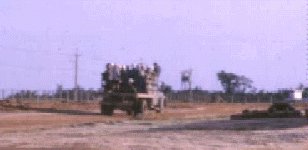
There is much more to the story and events that
took place that night, but these are essentially the details
of the circumstances surrounding the death of SSgt Terry K.
Jenson.